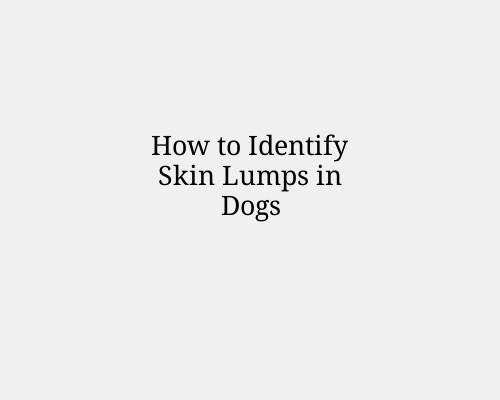How to Identify Skin Lumps in Dogs
Discovering a lump on your dog’s skin can be alarming, but not all lumps are dangerous. Many are benign and harmless, while others may require medical attention. Knowing how to identify different types of lumps can help you determine whether a vet visit is necessary.
Common Types of Skin Lumps in Dogs
Lipomas (Fatty Tumours)
Soft, round, and movable under the skin
Common in older and overweight dogs
Usually benign and painless
Sebaceous Cysts
Small, fluid-filled lumps under the skin
Can rupture and release a thick, white substance
Typically non-threatening but may become infected
Histiocytomas
Raised, red, and firm lumps
Often found in younger dogs
Usually resolve on their own
Warts (Papillomas)
Cauliflower-like growths
Common in younger dogs and caused by a virus
Typically harmless but can spread or become irritated
Abscesses
Swollen, painful lumps filled with pus
Often caused by infections or bites
Require veterinary drainage and antibiotics
Mast Cell Tumours
Can vary in size and appearance
May be red, swollen, or ulcerated
Can be cancerous, requiring medical evaluation
Melanomas
Dark, pigmented lumps
Can appear anywhere, including the mouth and paws
Some may be benign, but malignant melanomas can spread
Fibro-sarcomas and Other Soft Tissue Sarcomas
Firm, deep-seated tumours under the skin
Often slow-growing but can be invasive
May require surgical removal
How to Examine a Skin Lump on Your Dog
Check the Size, Shape, and Texture
Measure the lump’s diameter and note any changes over time
Soft and movable lumps are often benign, while hard, irregular ones may need medical attention
Monitor for Changes
Rapid growth, colour changes, or ulceration can indicate a problem
Persistent itching, bleeding, or oozing may suggest an infection or malignancy
Look for Multiple Lumps
Some conditions cause multiple lumps, such as warts or lipomas
The presence of multiple hard lumps may require immediate vet assessment
Assess Your Dog’s Behaviour
Signs of pain, discomfort, or frequent licking at the lump can indicate an issue
Loss of appetite, lethargy, or weight loss alongside a lump may suggest a serious condition
When to See a Vet
A lump that grows rapidly
A firm, fixed, or irregular mass
Bleeding, ulcerated, or inflamed lumps
Signs of pain, infection, or discharge
Lumps in sensitive areas like the mouth or paws
Your vet may perform a fine needle aspiration (FNA) or biopsy to determine whether the lump is benign or cancerous. In some cases, surgical removal or additional treatment may be required.
Conclusion
Regularly checking your dog for skin lumps can help detect potential health issues early. While many lumps are harmless, it’s essential to monitor for changes and consult your veterinarian for a professional evaluation when needed.

